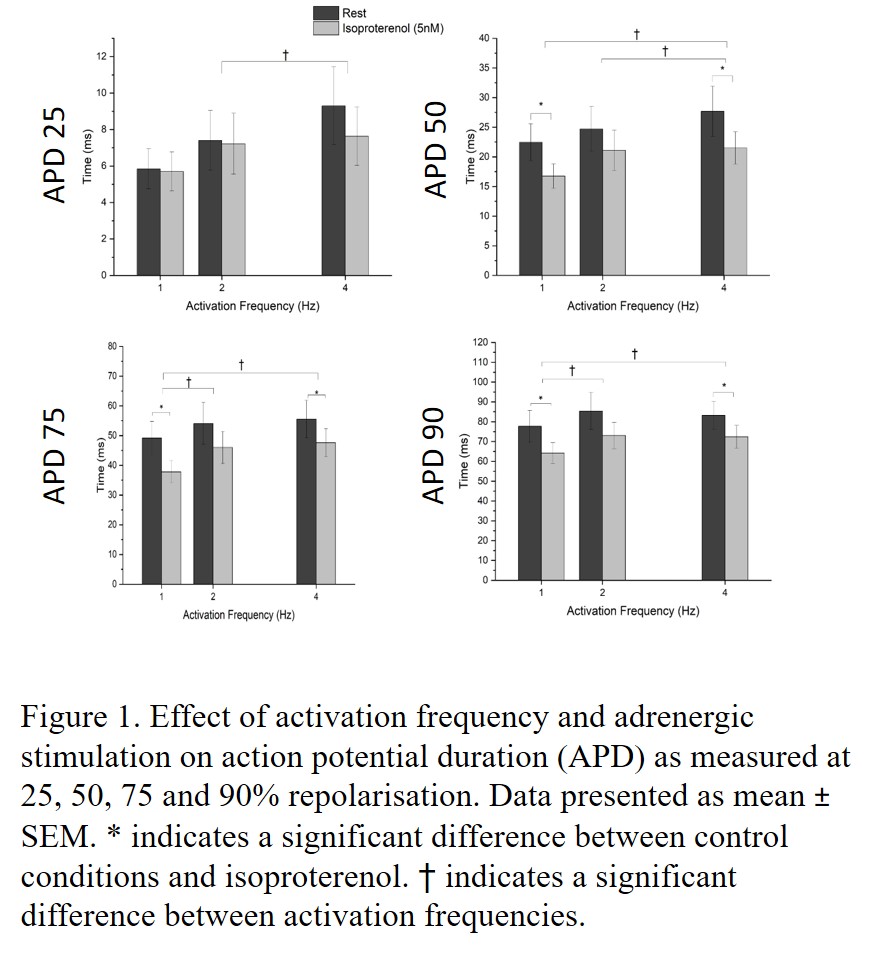Purpose: The adrenergic response is fundamental to modulation of cardiac function during exercise or stress. At the cellular level, past research has primarily investigated responses at one activation frequency and very high doses of adrenergic stimuli, often at ambient temperature. Data on rate-dependent and non-rate-dependent responses to adrenergic stimulation on ventricular myocyte repolarisation under physiological temperatures are key for being able to understand and reliably model cardiac responses to stress. We therefore investigated the impact of rate of pacing frequency and adrenergic stimulation on the rat ventricular action potential at physiological temperatures and levels of adrenergic stimulation. Methods: Adult (3 months) male Wistar rats (N = 13) were sacrificed in accordance with Schedule One methods stated in the Animals (Scientific Procedures) Act, 1986 and approved by the University of Leeds ethics committee. Whole-cell patch-clamp recordings on ventricular myocytes were made at physiological temperature (35-37°C). Action potentials were triggered by current injections in current-clamp mode using 2ms pulses. The intracellular solution consisted of (in mM): KCl 135, EGTA 10, HEPES 10 and glucose 5, pH 7.2. The extracellular solution consisted of: NaCl 136, KCl 4, MgCl 2, CaCl 1, HEPES 10 and glucose 10, pH 7.4. Action potentials were recorded with myocytes paced at 1, 2 and 4Hz before and after isoproterenol infusion (5nM). Action potential duration at 25, 50, 75 and 90% of full repolarisation (APD25, APD50, APD75, APD90) were compared between activation frequencies and resting and isoproterenol conditions. Changes in action potential duration (APD) are expressed relative to the initial APD recorded during pacing at 1Hz with no isoproterenol present. Data expressed as mean ± SEM. Results: Increasing activation frequency prolonged APD25-90 (p = < 0.01, repeated measures ANOVA). Action potentials recorded at 4Hz demonstrated a prolongation in APD25-90 of 7-59% (p = < 0.015), with the greatest prolongation observed at APD25 (59%) followed by APD50 (23%), APD75 (13%) and APD90 (7%). Action potentials recorded at 2Hz displayed a similar trend (Figure 1). Isoproterenol shortened APD50-90 but not APD25, by magnitudes of 17-25% and 13-22% at 1Hz and 4Hz pacing, respectively (p = < 0.05). Isoproterenol also stimulated APD50-90 shortening by 14-15% at 2Hz pacing, though not statistically significant. The greatest Isoproterenol-induced APD shortening was observed at APD50 followed by APD75 and then APD90 (Figure 1). Conclusion: This work displays the separate and combined effects of frequency and adrenergic stimulation on rat ventricular action potentials under simulated physiological conditions. The findings of this study suggest APD prolongs with increased rate and shortens with adrenergic stimulation. Rate-dependent changes in APD were greatest during early phase repolarisation (APD25), whilst isoproterenol-dependent changes in APD predominantly influenced APD50-90 indicating a greater role in late repolarisation and plateau phases. Though this study included a physiologically relevant dose of adrenergic stimuli and examined activation frequency toward a physiologically relevant basal heart rate for a rat (4Hz), the use of even greater rates (up to 10Hz) in future work will provide further insight into the effects of adrenergic stimulation on repolarisation across a physiologically relevant range.
Physiology 2021 (2021) Proc Physiol Soc 48, PC070
Poster Communications: Ventricular myocyte action potential responses to adrenergic stimulation and changes in rate
Luke Howlett1, Hannah Kirton1, Zhaokang Yang1, Moza Al-Owais1, Derek Steele1, Matthew Lancaster1
1 University of Leeds, Leeds, United Kingdom
View other abstracts by:
Where applicable, experiments conform with Society ethical requirements.

